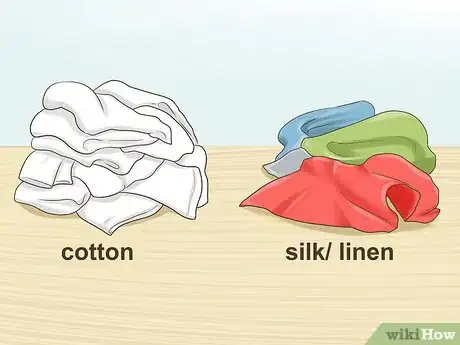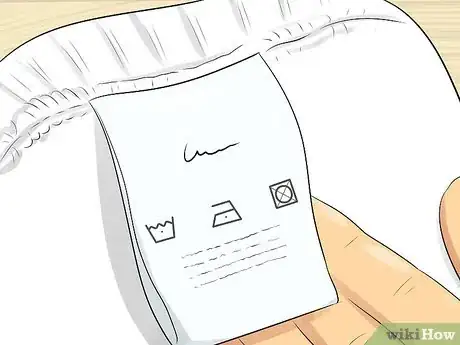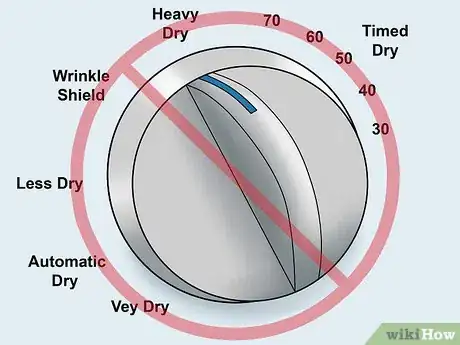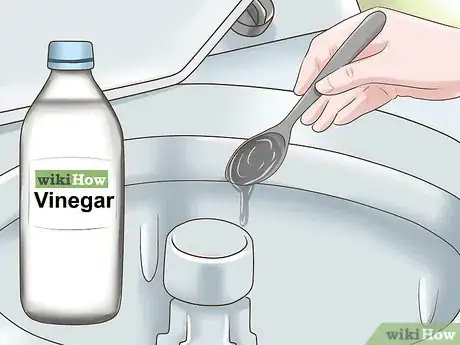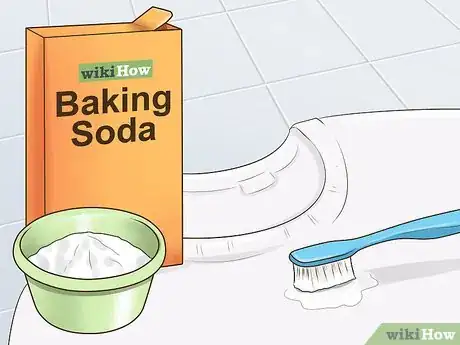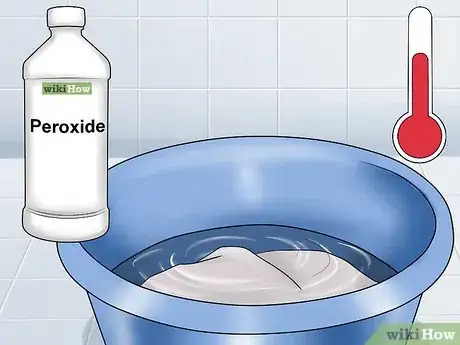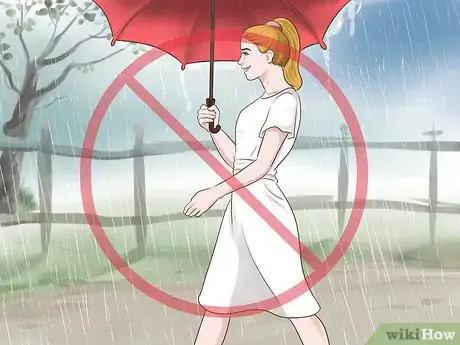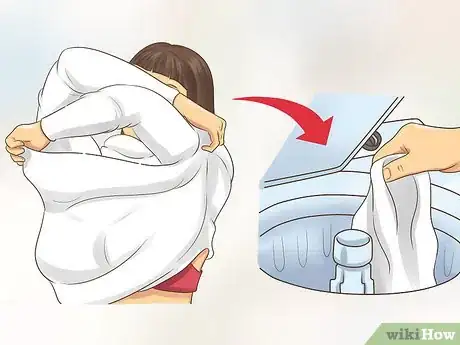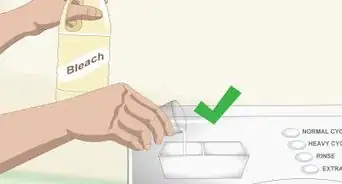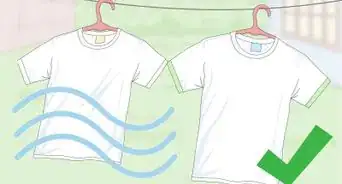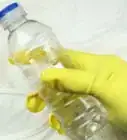This article was co-authored by Susan Stocker. Susan Stocker runs and owns Susan’s Green Cleaning, the #1 Green Cleaning Company in Seattle. She is well known in the region for outstanding customer service protocols — winning the 2017 Better Business Torch Award for Ethics & Integrity —and her energetic support of green cleaning practices.
There are 14 references cited in this article, which can be found at the bottom of the page.
wikiHow marks an article as reader-approved once it receives enough positive feedback. In this case, several readers have written to tell us that this article was helpful to them, earning it our reader-approved status.
This article has been viewed 491,810 times.
There is nothing quite as frustrating as slowly watching your whites turn varying shades of yellow, brown, and gray. Over time, whites tend to take on the colors of items they’ve come into contact with, including other pieces of laundry. Although keeping clothing items clean and vibrant can be difficult, there are ways to keep your whites truly white, including using the proper laundry settings, washing your clothes thoroughly, and wearing your whites carefully.
Steps
Sorting and Pre-Washing Your Whites
-
1Immediately take care of stains. If you are out and about, blot the stain carefully, but do not rub. If you have a laundry pen with you, you can dab the stain with that. If not, immediately remove the stained article of clothing upon coming home and use either a stain remover or a toothbrush and your standard detergent to pre-treat the stain.
- When pre-treating, always use a white cloth to dab away the stain, as a colored cloth may leave behind some dye.
-
2Separate whites from other colors. You can even go so far as to have a pile of more dingy whites, such as underclothes and socks, and a pile of crisp whites, such as dress shirts, or work attire. Whatever you decide, this is a step that cannot be skipped under any circumstances.[1] [2]
- While it may be tempting to throw really light colors in with your whites, or even light grays, stick to white alone.
- If you need to, adjust your washer's settings to account for a smaller load—if you use too much water, it could interfere with the cleaning power of your detergent.
Advertisement -
3After a pre-treatment with a detergent or stain spray, soak your whites in hot water. After each spot treatment, rinse and soak them for 30-60 minutes in hot water. This will help lift any lingering stains, and will give the treatment a chance to dissolve.[3]
- If you used a lot of soap, you may need to repeat this step twice, gently squeezing the garment in between soaks.
- If your laundry is sensitive to hot water, a warm or cold soak will achieve the same effect, though to a lesser degree.
-
4Sort according to fabric. The type of fabric will determine the ideal wash cycle; some fabrics can withstand extremely hot water, while others will shrink or become disheveled. Sort your white laundry according to color, as well as fabric, to avoid discoloration and disrepair.[4]
- For instance, cotton can withstand high temperatures, but wool and linen should be washed in cold or warm water. Synthetic fibers vary from manufacturer to manufacturer.
Using Proper Laundry Settings
-
1Check your tags. The fabric and cut of your clothing will play a significant role in the type of wash cycle you should use. Instead of merely sorting your piles into whites and throwing all of your whites into a one-size-fits-all washer setting, wash and dry each of your whites according to the tags’ specifications.[5]
- Although it may seem easier to just throw all of your delicates together, different fabrics require different care and washing settings. If you don't pay attention to the label, you could damage the fabric.
-
2Use the hottest setting. Hot water lifts debris and disinfects. To keep your whites white, use the hottest setting your washer (and your fabric) will allow.[6] The exception to this rule is, of course, when delicate fabrics such as silk, linen, and wool come into play.[7]
- Once a month, run an empty load with hot water and vinegar to remove buildup and residue that could transfer to your clothes and stain your whites.
-
3Make sure the rinse cycle is thorough. A rinse cycle is designed to rinse away detergent, dirt, and debris. If the rinse cycle is impeded in any way, dirty water will soak into your whites. If you have the option, run your whites through a second rinse cycle to make sure everything has been washed away.[8]
- You can skip the extra rinse cycle if you're concerned about adding the extra cost to your water or electric bills.
-
4Avoid the dryer. The heat from the dryer can set stains deeply into fabric. Whenever possible, avoid drying your white clothes, instead hanging them to dry. As an added benefit, your whites will last longer; the extreme heat used in the dryer can cause fabrics to break down and wear through more quickly, which means replacing your favorite white items more often.[9]
-
5Dry in the sun. If you have the option, dry your whites in the sun; the sun acts as a wonderful bleaching agent, and can be an indispensable tool in keeping whites white. In addition, the outdoor air may provide a natural method of giving your clothes a fresh, clean smell.
- Give your clothes a check for bugs on your clothing before bringing them in!
- If you cannot dry clothes outdoors in the sun, drying next to a sunlit window is the next best thing.
Using Extra Whiteners
-
1Pour vinegar into your washer. Vinegar’s acidic nature helps disinfect and remove stains, and can also remove unpleasant smells, such as mold mildew, and body odor. If your whites have been overtaken by poor smells, vinegar is the best option to remove them. All it takes is between 1 tablespoon and ¼ cup poured directly into the wash basin or detergent reservoir.[10]
- Do not overdo vinegar use; because vinegar is acidic, too much can cause damage to your clothes over time.
-
2Squeeze pure lemon juice into your laundry. Lemon juice is an all-natural bleaching agent. You can use lemon essential oil, pre-squeezed lemon juice, or juice directly from a lemon. If you juice your own lemons, be sure to strain the juice through cheesecloth or a thin strainer to prevent getting lemon residue on your clothes.[11]
- If you are using lemon juice, mix the juice of two lemons with 1 US gal (3,800 ml) of warm water and soak your clothes for 30-60 minutes.
- If you are using lemon essential oil, simply place 2-3 drops directly into the wash bin.
-
3Make a baking soda paste. To remove stains, you can make a paste with baking soda and warm water, then apply this mixture directly to the stain using a toothbrush or clothes brush.[12] Allow the stain to soak in the mixture for 10-15 minutes before running it under warm water.
- Repeat this treatment as many times as you need to until the stain is gone. Just be sure to thoroughly rinse the garment each time or the fabric could become brittle.
-
4Coat stains in peroxide. Peroxide is an excellent, safe way to get tough stains out of clothes. Peroxide is particularly useful for removing blood and other dark, hard-to-lift stains. Once you have pretreated a stain, place the stained or discolored item in a tub filled with hot water and peroxide. Peroxide disinfects and cleans, and provides a safer alternative to bleach.[13]
- Peroxide is a bleaching agent, so it may stain dark or colored fabrics.
-
5Use bleach as a last resort. Although bleach is useful in disinfecting and whitening clothing items, there is some doubt as to how safe it is for use. Being a harsh chemical, bleach can begin to break down the fibers in a given fabric, weakening it and causing tears.[14]
- Always keep bleach out of the reach of children and pets.
- Also, bleach is flammable, so keep it away from fire hazards such as the stove or dryer.
Wearing Your Whites Carefully
-
1Avoid wearing your whites on days you’ll be outside. If you know you will be outside a lot, or outside in rainy or windy weather, skip your white clothes in favor of a more forgiving color. Although whites do not have to be stuffed into the back of your closet or set aside only for calm, careful lounging indoors, to keep your whites a brilliant white, you do have to be careful how and when you wear them.
- If you're wearing white to stay cool during the summer, stick to wearing white tops.
- White shoes and bottoms will get dirty quickly, especially if you'll be outside or you get caught in bad weather.
-
2Watch what you eat. White clothes and pizza do not mix. The same goes for virtually any dish with a tomato-based sauce, or a food item with a dipping sauce. Opt instead for fresh ingredients (think vegetables and salads) whenever possible, as few of these ingredients stain.[15]
- If you're wearing white and you find yourself eating something messy, tuck your napkin into your collar or spread it over your nap to catch drips.
-
3Avoid whites with children. Children spiffed up in their Sunday best are undeniably adorable. Children covered in dirt and food, while also adorable, are highly likely. Trying to keep whites white with children is a difficult task. Although using these tips and tricks will help, largely avoiding whites for children will prove an easier task.
- If you must use whites with your children, treat any stains immediately upon removal.
- White onesies and T-shirts are often stained yellow from drool. To prevent this difficult-to-remove staining, use drool bibs or handkerchiefs.
-
4Wash whites after each wear. While some clothing items allow you to wear them 2-3 times before needing a wash, whites do not hold up quite as well. Each time you wear your white clothes, they should be washed. Even if you can’t see dirt or grime, everything from the sweat of your body to the chemicals contained in your deodorant has the potential to turn your whites a dingy yellow or gray. These items should not be allowed to linger any more than necessary.[16]
- For jeans and skirts, wash every 1-2 wears. Bottoms are typically made of a hardier fabric and can take more of a beating, so to speak.
Community Q&A
-
QuestionHow can I wash a brown and white striped shirt to keep the white white?
 Community AnswerDon't wash it with your colored clothes and don't use hot water on it. Wash white-striped and other white-plus-color clothes in cold water. Use the smallest amount of detergent that will do the job. (Experiment; most people use too much. You should only see a bubble or two, not suds.) Rinse very thoroughly -- one soap cycle and two rinses work better than the other way around. Traces of leftover soap build up can make both colors and whites look dingy. If possible, hang the clean shirt on a hanger to air dry (though not in direct sun, which will fade the stripes). Heat-drying, too much detergent, and hot water wear colors and clothes out faster.
Community AnswerDon't wash it with your colored clothes and don't use hot water on it. Wash white-striped and other white-plus-color clothes in cold water. Use the smallest amount of detergent that will do the job. (Experiment; most people use too much. You should only see a bubble or two, not suds.) Rinse very thoroughly -- one soap cycle and two rinses work better than the other way around. Traces of leftover soap build up can make both colors and whites look dingy. If possible, hang the clean shirt on a hanger to air dry (though not in direct sun, which will fade the stripes). Heat-drying, too much detergent, and hot water wear colors and clothes out faster. -
QuestionWhat is oxygen bleach?
 Community AnswerOxygen bleach is a solid mixture of sodium carbonate (washing soda) and hydrogen peroxide. It is much less corrosive than chlorine bleach. When mixed with water, oxygen bleach releases oxygen gas, killing bacteria and decolorizing many compounds in colored stains. Oxygen in the air has the same effect, especially in sunlight. This is why sheets that have become stale-smelling in storage can be freshened by "airing" them in open air and sunlight.
Community AnswerOxygen bleach is a solid mixture of sodium carbonate (washing soda) and hydrogen peroxide. It is much less corrosive than chlorine bleach. When mixed with water, oxygen bleach releases oxygen gas, killing bacteria and decolorizing many compounds in colored stains. Oxygen in the air has the same effect, especially in sunlight. This is why sheets that have become stale-smelling in storage can be freshened by "airing" them in open air and sunlight.
Warnings
- If you slip up and stain a much-loved white item, avoid drying the article of clothing until the stain has been removed.⧼thumbs_response⧽
References
- ↑ http://www.grandparents.com/food-and-leisure/home-and-garden/how-to-wash-white-clothes
- ↑ Susan Stocker. House Cleaning Professional. Expert Interview. 8 November 2019.
- ↑ http://www.nytimes.com/2009/10/08/garden/08fix.html
- ↑ http://www.mamaslaundrytalk.com/laundry-basics-how-to-sort-clothes/
- ↑ https://www.ftc.gov/tips-advice/business-center/guidance/clothes-captioning-complying-care-labeling-rule
- ↑ Susan Stocker. House Cleaning Professional. Expert Interview. 8 November 2019.
- ↑ http://www.maids.com/blog/pros-and-cons-of-washing-your-clothes-in-hot-water/
- ↑ http://www.huffingtonpost.com/2014/05/06/laundry-mistakes-how-to-wash-clothes_n_5241398.html
- ↑ http://www.bhg.com/homekeeping/laundry-linens/clothes/dry-clothes/
- ↑ http://www.dailymail.co.uk/femail/article-3099843/Want-whites-WHITE-Wash-vinegar-tips-best-wash.html
- ↑ https://brightside.me/inspiration-tips-and-tricks/7-simple-ways-to-keep-your-whites-white-203405/
- ↑ Susan Stocker. House Cleaning Professional. Expert Interview. 8 November 2019.
- ↑ https://www.onegoodthingbyjillee.com/30-uses-for-hydrogen-peroxide-youll-want-to-know-about/
- ↑ http://universityhealthnews.com/daily/eyes-ears-nose-throat/are-bleach-fumes-dangerous-bleach-exposure-increases-risk-of-infection-in-kids/
- ↑ https://www.pgeveryday.com/home/cleaning/article/13-stubborn-stains-and-how-to-remove-them
- ↑ http://www.goodhousekeeping.com/home/cleaning/a24670/3-secrets-to-keeping-your-whites-white/
About This Article
To keep your white clothes white, only wash them with other white garments. Even light colors, like light grey, can ruin your white clothes if you wash them together. When you do a load of whites, use the hottest setting on your washing machine since hot water will lift stains. Also, try to avoid machine drying your whites if possible since the dryer can cause stains and discoloration to set and become permanent. Air drying is preferable, or you can hang your whites up to dry in the sun, which will act as a bleaching agent and make your clothes whiter. To learn how to use lemon juice, baking soda, and vinegar to keep whites white, scroll down!




